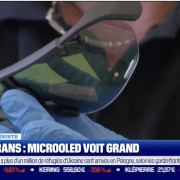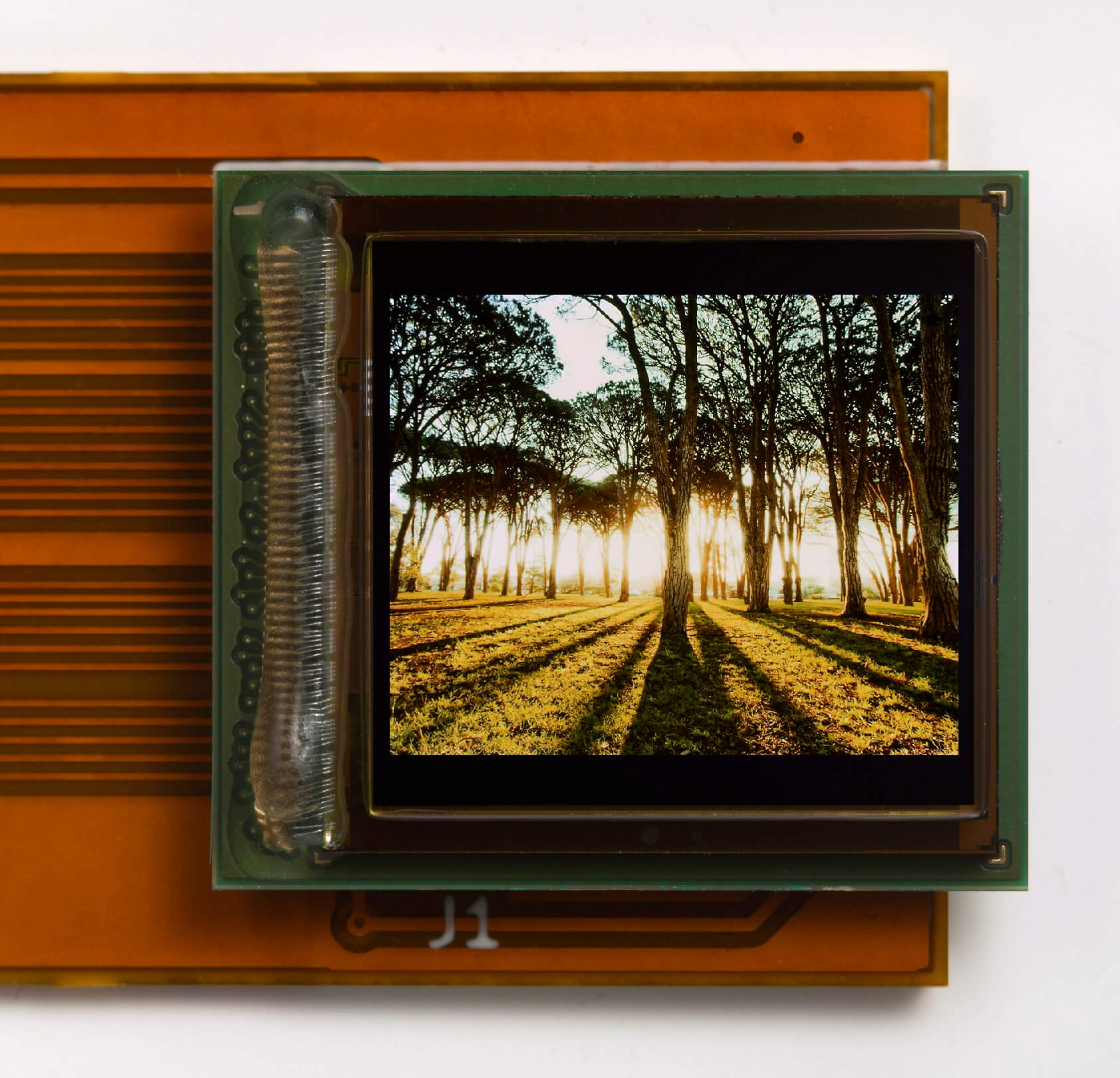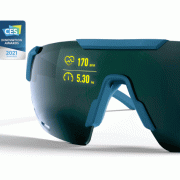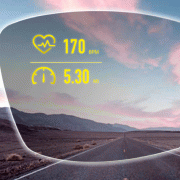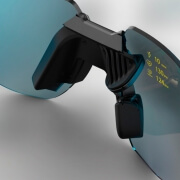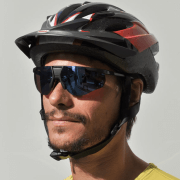Eric Marcellin-Dibon CEO of MICROOLED and ActiveLook® was on BFM Business last morning with Jeanne Spicarolen to talk about our connected glasses and our AMOLED microdisplays.
To see the interview click here !
Suunto®, the iconic Finish brand, opens its API to the Activelook® technology to connect its watches to the world’s lightest AR eyewear
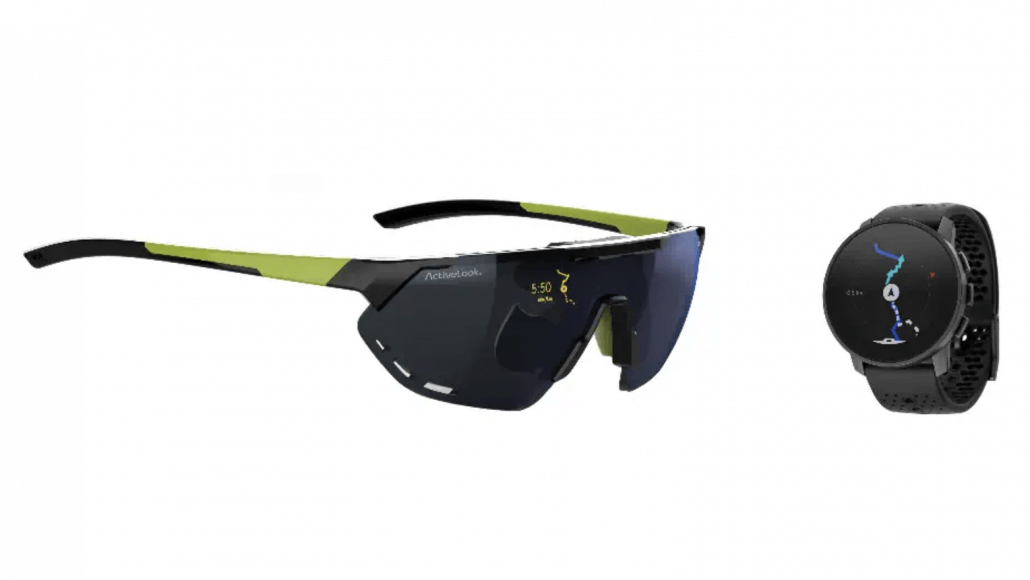
February 28, 2022 – Two European players, Activelook®, the head-up display technology integrated in smartglasses, and Suunto®, the Finnish manufacturer of sports watches, are pleased to announce their exclusive partnership at Mobile World Congress. Thanks to this partnership, the sport data measured by the Suunto devices can now be displayed on the world’s superlight AR eyewear to enhance the performance of any athlete and outdoor adventurer.
A unique AR technology for a complete sports experience
ActiveLook® is an embedded head-up display technology that fits into sleek, lightweight frames and lenses. A dedicated software & hardware technological platform allows any eyewear and sports manufacturers to easily take a leap into AR technology.
ActiveLook®’s miniaturized and invisible AR technology displays essential performance data without obstructing the field of vision. Specifically, a smart chip integrated into the eyewear projects data to a discrete near-eye display that “melts” into the optics. It gives access in real time to whatever data is monitored by athletes as they train or compete, such as distance covered, elapsed time, their speed, pace, or heartbeat.
A hands-free coach in AR
Already recognized as a driver to improving the athlete’s motivation and safety, the real-time data monitored by the Suunto devices adapts to any sport practiced at any level: barometric altitude, route navigation, sport-specific maps, etc., while providing an overview of key indicators (distance, speed, heart rate, cadence, etc.).
Thus, the combination of ActiveLook®’s AR eyewear with the Suunto sport watches came almost naturally, to offer a totally immersive and renewed sporting experience. Boosted by sensors, the smart watch works as the central calculation unit gathering all the key data needed by the athlete. The smartglasses then send the data to the athlete, ensuring a simple, discrete and intuitive visuals access to their performance. A key to long term sport practice success!
Coaching & Orientation: The immersive experience of running
The projection in the smart glasses provides athletes with the ideal conditions to enhance training, motivation and performance. For outdoor sports, ActiveLook® and Suunto’s blend of expertise is the perfect complement. So, when the athlete is running alone in the wilderness, riding a forest trail on a mountain bike, riding in a pack, training in a group, or tackling difficult slopes and tight turns, the data is automatically projected on the near-eye display. It saves time and allows the athlete to focus on their practice and experience without having to make any additional gesture to access their data.
It also makes the journey safer. Thus, featuring “road” alerts that are sent to the athletes while running, the Suunto® watches allow them to adapt their practice, equipment and effort to gain in performance, skill and safety. The experience becomes immersive, as the Activelook® smartglasses unleash the latent value of the high-performance sensors integrated into the Suunto® watches.
Technology at the service of people and sports
Xavier Bonjour, Marketing & Partnerships Director of ActiveLook®, explains: “With our technology, the head-up display enters a new era: athletic performance and safety. It proves that this technology has become mature! Free of distortion or distractions, the glasses can now offer new services that make sport safer and more fun”.
Janne Kallio Head of Partner Products of Suunto®, adds: “Athletes using Activelook with Suunto watches will be able to fully focus on their experience running in rocky trails or speeding down the mountains with their bikes or skies. This co-operation really brings future innovation to today’s consumers”.
The complementary nature of connected watches and glasses is ushering in a new era in sports. It extends the already successful indoor sports experience of players such as Peloton and Swift to the outdoors. Activelook® is a new kind of partner for the Finnish watch brand. For the first time, Suunto® is opening up its devices and technology to third-party content. A promising European and technological collaboration in many multi-device uses.
A prototype of the ActiveLook®- compatible Suunto® app was on display during MWC in Barcelona, Spain, February 28 to March 3, 2022, at Hall 7 Stand 7E23.
The prototype was functional on the latest Suunto® 9 Peak and work with any eyewear integrating ActiveLook®’s technology.
Activelook® is on the shortlist for Glomo Mobile Awards 2022 in the Best Connected Consumer Devices category.
About d’ActiveLook®
ActiveLook® is the specialist augmented reality division of the French company MICROOLED, which manufactures high-resolution OLED microdisplays with very low energy consumption. ActiveLook® is developing a compact module that can be integrated into eyewear and connected to a smartphone or smartwatch app to manage the data screened on the near-eye display. The system works in conjunction with the ActiveLook app, which is compatible with Garmin and other devices. This solution has already been adopted by sports eyewear manufacturers including Julbo, Engo eyewear, and now Cosmo Connected. https://www.activelook.net/
About Suunto
We stand for adventure. Pioneering exploration has been in our DNA since 1936, when Finnish orienteer Tuomas Vohlonen set out to create a more accurate compass, and subsequently invented a new method for manufacturing liquid‐filled compasses. Today Suunto is at the forefront of design and innovation for sports watches, dive computers and instruments used by adventurers all over the globe.
Eighty-four years removed from our founding, we are proud that Suunto products can take a beating, but are also designed with an everyday aesthetic that reflects our Nordic identity. Suunto’s headquarters and factory are still in Finland. https://www.suunto.com
ActiveLook® is proud to announce its partnership with Cosmo Connected, the French developer of connected urban micro-mobility safety solutions. Developed by MICROOLED, ActiveLook® offers a miniaturized and invisible augmented reality device that displays navigation information via a Head-up display.
How does it work?
Eyewear equipped with ActiveLook® technology contains an embedded and invisible microdisplay that, depending on the sport concerned, shows route, speed and heart rate data without obstructing the wearer’s view of the horizon. The heart of the ActiveLook® module is based on a monochrome AMOLED display with 304 x 256 pixels resolution consuming less than 1 milliwatt; 3times less energy than the most advanced of its competitors. With a battery life of more than 12 hours, and weighing just 6g, ActiveLook® provides a readable display regardless of ambient light conditions. The ActiveLook® device connects via BLE (Bluetooth Low Energy) to a smartphone, watch and to some more specific sensors (heart rate sensor, power sensor, etc.).
CosmoVision eyewear: a partnership between Cosmo Connected and ActiveLook®
As part of its forward development path, ActiveLook® is now looking to the world of sport and urban micro-mobility to meet the daily needs of travel and sport. In this context, mixed reality that delivers navigation and physical performance data considerably improves the safety margin of wearers. Since 2000, screens have become part of our daily activities lives and our lives increasingly depend on them. In developing a new product category of connected eyewear,
ActiveLook® is offering its users the opportunity to follow their route safely with no need to look at their smartphone.
ActiveLook® Founder Eric Marcellin-Dibon says: “Mass adoption of AR relies on discrete integration. Consumers aren’t prepared to put on superhero helmets, but they definitely do want eyewear that helps them to see and do their activity better. We believe that ActiveLook® is the inevitable technological evolution of the eyewear that has been making our lives easier for centuries”.
Cosmo Vision connected eyewear will be available for pre-order at €489 from 18 October via the Cosmo Connected website, and previewed in the Alain Afflelou retail network starting early in December.
In November, we responded to the call for national projects by highlighting the strong growth of
our results, and the market opportunity for ActiveLook®️ augmented reality (AR). #francerelance #madeinfrance #oled
https://www.presences-grenoble.fr/actualites-industrie-grenoble/microoled-redouble-de-visibilite.htm
2020 marked a turning point for MICROOLED, in particular thanks to the fundraising of 8 million last September. Meeting with Eric Marcellin Dibon, CEO and co-founder of MICROOLED.
1. What were the highlights for MICROOLED in 2020?
EMD : “The past two years have been excellent for MICROOLED. We achieved very good growth by first passing the symbolic barrier of 10 million euros in turnover in 2019 and then the cap of 20 million euros in 2020. Heavy investments were made and allowed for the set up of a second Oled production line. Our production capacity has been multiplied by more than 3 in 2 years. To support this growth, our team grew extensively, welcoming 30 new employees over the past two years.
The year 2020 was also marked by the market launch of EVAD-1 eyewear by our customer Julbo, which works with our ActiveLook system. This is a new turning point for us, because until then we were positioned in a very technical market and we are now entering the sports eyewear market.
2. Has the Covid 19 health crisis had an impact on microoled?
EMD : The COVID-19 crisis has not had an impact on our sales. On the other hand, the semiconductor sector being a sector under general tension, we have observed difficulties and slowdowns in terms of supplies. This was a barrier to meeting our delivery commitments.
MICROOLED’s production remained operational with a shutdown of only two weeks throughout the year.
Of course, we have reduced travel and demonstrations, which is extremely frustrating, because our products need to be tried out and tested by customers. So we look forward to meeting again with our customers.
3. What are the group’s challenges for 2021?
EMD : 2021 is shaping up nicely as yet another growth year for the company. The real challenge is to support this rapid growth.
Although 95% of our sales are already made abroad, our ambition is to extend our efforts, particularly in the USA, Asia, and Europe.
Another challenge for 2021 is the further development of Activelook’s strategy with new eyewear brands”
CES® is the most influential tech event in the world — the proving ground for breakthrough technologies and global innovators. We are very proud to have received this award in the Embedded Technologies category.
We also received an award in the Sports & Fitness category, with the EVAD-1 from our customer Julbo, sport glasses set to revolutionize sporting activities.
YD: OLED-on-Silicon is a mature technology but has long been affiliated with specific applications like electronic viewfinders, sports optics and defense. What are the advantages of this technology compared to the other incumbent ones?
Gunther Haas (GH): First of all, one main differentiator of OLED-on-Silicon technology compared to other established microdisplay technologies like LCoS is the excellent contrast and overall picture quality. Especially for near-to-the-eye applications, users are very sensitive to this as there is no light from the external environment affecting the display image. We developed an OLED technology with excellent uniformity. The gap between the pixels is so small that it is invisible. In addition, our pixel structure has even smaller sub-elements due to our quad pixel arrangement. Compared to LCOS or LCD microdisplays, the difference in picture quality is very visible in an electronic viewfinder. This is key for digital cameras, but also for defense applications because it relates to the distance of detection. In addition, for head-up or AR-type applications, where the display image is optically laid over the user’s natural view, we can provide extremely high contrast, meaning a black level close to zero, which is mandatory in order not to get parasitic light in the user’s view.
Secondly, our OLED-on-silicon technology has a much better power efficiency compared to our competitors, and to the other technologies mentioned. The display, with its optical system, has a very compact footprint as it does not require external illumination. All near-to-eye applications are portable and battery-operated, so a power-efficient and compact technology really make the difference. This is especially key for eyewear VR/AR applications.
Last but not least, the wider temperature range and faster response times compared to LCD and LCOS have been one of the main drivers for defense and sport optics applications, where LCOS or LCD are now rarely used.
YD: AR has been promised for many years. Given the need for a microdisplay technology, OLED-on-Silicon products have tried to make a push for this application in wearables and headsets. What would be the advantages of using OLED-on-Silicon?
GH: In the AR space, initially LCOS-based systems were dominating because they can provide very high brightness, but it was at the cost of a bulky and power-hungry system with low picture quality. As explained before, AR glasses require compact and power-efficient displays with very high contrast. As of today, only OLED microdisplays can deliver this. In the past, the limited brightness of OLED microdisplays has been the main limitation. However, advances in OLED materials as well as new device architectures we developed, have allowed us to overcome this issue. As the first products based on our ActiveLook platform impressively demonstrate, OLED microdisplays can be used in full optical see-through systems, even in the brightest sunlight. These first products are based on a monochrome display, but a two-primaries red and green microdisplay is used by another customer in an AR system for outdoor applications. We currently have full-colorr versions of high brightness OLED microdisplays under development and sampling to our customers.
YD: You very recently raised 8M€ to accelerate the deployment of your ActiveLook Smartglass Platform. What is this platform?
Eric Marcellin Dibon (EMD): ActiveLook is a compact module for AR sunglasses, which connects to various devices, such as mobile phones and smartwatches. The overall system weighs less than 7g with over 12-hour autonomy, including battery, optics, microdisplay and full electronics.
Our first target was the sports eyewear market, and we wanted to do it differently from all the other techie smartglasses. Everything is built around our core technology, our ultra-efficient high brightness microdisplay, with only 1mW power consumption. We designed the system to be very lightweight and to enable stylish good-looking sport sunglasses that are indistinguishable from regular eyewear, and are designed to project data directly in the lens without obstructing and obscuring your vision. Julbo, the extreme sport sunglass maker, recently introduced the EVAD-1digital sports glasses this year. They did a fantastic job integrating our ActiveLook module. We are very proud of this collaboration. The design is amazing. The glasses are very comfortabl, and include photochromic lenses. When you wear them, nobody can guess it includes a real heads-up-display. The Julbo EVAD-1 comes with an ActiveLook sport application, which is available on the Apple App Store, Google Play, and Connect IQ from Garmin.ActiveLook is an open platform. It includes a Software Development Kit, which enables partners to develop their own custom-designed applications. We are working with many partners who see a unique opportunity to extend their market access by making their data available directly in the ActiveLook module. Examples include coaching applications and performance monitoring. Thanks to its low weight, long-duration autonomy, and form factor, ActiveLook will also be an excellent platform for industrial applications, such as connected safety glasses. We have many projects in the pipeline. This is a very exciting time for us.
YD: Why have you decided to go towards developing more than a display, and producing a complete platform? Was it an internal effort or a pull from your clients and partners?
EMD: We have always been a very customer-focused company. Step by step it became obvious that our customer base and new markets were looking for solutions rather than just a microdisplay. It is especially true for new use cases and augmented reality. The consumer brands are very strong in marketing, product design, and retail, but they do not necessarily have a good understanding of the technology. Many have tried to assemble technology parts together but for a poor result. This is where we have a key role to play.
We were convinced that by taking into account the requirements of the customer’s product, from an end-user point of view, we could do things differently, by optimizing the technology all along the chain, from the optics to the microdisplay and the electronics.
At the beginning, it was fully an internal effort, we had to grow the team, integrating many forms of expertise, including mechanical, system engineering, optics, and firmware. Our deep understanding of microdisplays, video, and optics technologies helped us to develop a module that meets market demand. Very quickly customers approached us and started collaborating on projects together. We provided the expertise and technology they did not have. We have many partners working with us to develop new products and use cases. Julbo’s EVAD-1 sunglasses are the first of these projects. We will extend ActiveLook to many customers and partners but also to other AR applications.
YD: A long-talked but still prototype early-phase technology has been around for a few years now, namely microLEDs. There is lots of promise but no product yet. Do you see this technology as a threat?
GH: The display industries always went through major technology changes, from cathode ray tubes to liquid crystal displays, to OLEDs. For sure new technologies will arise. However, some did not succeed or had very limited market access such as field emission displays, plasma, and DLP, because their key features only matched niche market requirements.
We have so far seen early prototypes of monochrome microLED based microdisplays with very high brightness. However, the samples show many defects and it is not really possible to evaluate picture quality. There are numerous technical hurdles that would have to be overcome for microLEDs before becoming a competitive microdisplay technology even for monochrome displays.
In contrast to OLED-on-Silicon, microLED-on-Silicon is a heterogeneous technology. This means that millions of interconnects at pixel level are required in order to connect the individual pixel circuits to the corresponding microLED element. It is not clear how a reasonable manufacturing yield can be achieved for these interconnects as only very few or sometimes zero-defect pixels can be tolerated in a display. Also, the overall manufacturing process is very complex and includes further steps for pixelization and common connection of the LEDs as well as steps like substrate release. Overall, the cost of manufacturing will be very high.
The efficiency of microLEDs drastically decreases with pixel size, and from available data, we can see that power consumption will be significantly higher compared to OLED, at equal brightness.
MicroLEDs require pixel-to-pixel homogeneity calibration including full-frame memory, which increases both cost and power consumption.
In addition, for AR and other near-the-eye applications, there is no real advantage. The required brightness for monochrome applications is easily met already by our OLED-based microdisplays. However, I think it is in principle possible to realize such monochrome microdisplays that could be used for projection applications where really high brightness is required and where power efficiency and cost are not essential.
When it comes to color, as of today there is no realistic solution how to make full-color microLED-based microdisplays. Full-color direct view microLED displays using color conversion via red and green Quantum Dots has been demonstrated, however with a quite low resolution of 100-200ppi, and with rather low brightness. In microdisplays, we typically have resolutions between 2000 and 4000ppi which correspond to pixel sizes down to 6µm, which is impossible to realize with quantum dots.
Many efforts in microLED today target larger size, relatively low-resolution direct view displays, using mass transfer techniques from red, green, and blue microLED wafers to large glass substrates. I cannot comment on how successful this might be, however, I do not see how microLED technology for very high-resolution displays like microdisplays could become a reality.
On the other hand, OLED materials and devices, in general, are still making significant progress. There is a large critical mass of material and technology developers behind. One example is the recent progress in highly efficient blue emitters. For microdisplays, we are currently making great progress in terms of efficiency and light output, as well as for optical systems for AR applications which are becoming more efficient as well. Only few applications like projection or some HUD-type applications really require extremely high brightness. Therefore, there will be only a very small space for an expensive and very capital-intensive technology to breakthrough. It is not obvious that even if all the technical and cost-related problems could be solved that this technology will reach the market.
MICROOLED, a leading provider of low-power high-resolution OLED microdisplays, announces an €8 million growth investment provided by two pan European high-tech investors, Cipio Partners and Ventech. These investors will join the company’s Board of Directors along with the historical investor Supernova Invest through CEA Investissement.
MICROOLED offers cutting-edge OLED microdisplays to a broad and global customer base for diverse of applications, from consumer electronics to highly demanding professional use cases. By combining its 13-year expertise in display, manufacturing, and system integration with a strong knowledge of the market, MICROOLED recently introduced ActiveLook, the lightest and most compact optical module for smart glass applications, which is being adopted by eyewear companies such as Julbo, UVEX and others.The company was established by Eric Marcellin-Dibon, CEO, and Gunther Haas, CTO, in 2007 and employs over 75 highly skilled team members in Grenoble. It had been able to rely on investment by Supernova Invest, through CEA Investissement. The company has experienced record growth in 2019 with a net profitable result. The team will use the funding to further push the development of integrated AR modules while strengthening manufacturing capacities to support increasing global demand for OLED microdisplays across all type of use cases.
“We are ready to innovate with our customers, developing unique solutions based on our high-efficiency OLED technology”, said Eric Marcellin-Dibon MICROOLED CEO. “Augmented reality represents a huge market opportunity. Connected eyewear is everything about style and comfort and a successful product can only be achieved with a highly integrated system and by mastering the key technologies down to the pixel. This is our core expertise and with this strong investor pool, we have the resources to enable our customers to enter these new markets with our ActiveLook platform”.
Christian Claussen, General Partner with Ventech states: “I have closely followed MICROOLED’s growth path over the past years and am impressed with management’s ability to develop cutting-edge world-class technology with a strong focus on real customer needs. MICROOLED will now open a completely new chapter in consumer-AR thanks to their ready-to-market Active Look platform. We are more than happy to support management with funding and advice during the next growth phase of the company.”
An interview from Materialise with Eric Marcellin-Dibon, CEO, and Xavier Bonjour, Product Marketing Manager of Microoled, the company behind ActiveLook – one of the newest concepts in smart sports tech.
Welcome both. Can you perhaps start by telling us about ActiveLook?
Xavier: Of course. ActiveLook is a system that enables sports brands and eyewear manufacturers to transform their glasses into live, personalized, performance information displays.
The concept is quite simple; patented lens technology we’ve developed ‘activates’ lenses to receive and transparently show sports/physical performance information from a miniaturized AMOLED microdisplay enabled with compatible software. This software means the wearer will easily be able to pair – via Bluetooth – their eyewear with market-leading apps on their smartphones, smartwatches or fitness trackers, etc. In summary, it means any sports eyewear brand will have the opportunity to harness augmented reality technology to offer an exciting ‘value add’ for its customers.
The concept may be simple, but was making it a reality straightforward?
Eric: Ha! Not quite. But that was because we wanted to come at this from a different angle. There have been attempts to launch smart eyewear in a sport before, but many have failed because they were tech-led in their approach. They tried to make smart glasses suitable for sport, the result being technical capability let down by frames that were too heavy, awkward, and unattractive to wear – especially in an active sports setting.
So, while our starting point was our micro OLED display technology, optics, and electronics – and reducing the weight of these components down to just 9 grams – our ‘to market’ proposition had to be driven by what wearers want. Sports glasses and sunglasses that look and feel great. People want sports eyewear that’s smart, not smart glasses for sport – and that’s why 3DP became the perfect enabler for us.
Tell us a little more about that – how did your journey with 3DP begin?
Eric: We were already familiar with 3D Printing as a prototyping tool – we use it in-house at Microoled a great deal. And we always knew that this was a route we would go down with prototypes for ActiveLook as it would enable rapid design iterations to ensure our complex technology could truly be ‘invisibly’ integrated into eyewear.
What we hadn’t considered was 3DP for mass production, for that we had intended to go down an injection molding route.
What changed your mind?
Xavier: About a year ago we started to see 3DP gain more traction as a mass production tool and began to investigate opportunities. We hit a few dead ends but were then introduced to Materialise. Something stood out. Materialise is a 3D Printing specialist actively developing solutions for, and working collaboratively with, eyewear brands – a tech company taking an application-led approach. Just like us.
We visited the factory and saw for ourselves what was possible. How mass production processes worked, the production capacity on offer, and the print consistency achievable. I also remember thinking, if this is a company Airbus trusts for accuracy and volume, that’s a pretty good endorsement
Eric: To appeal to our target market, big sports and eyewear brands, we didn’t just need a great technical system – which we believed we had. We wanted to be able to offer design and production flexibility; a way they could always integrate our technology into eyewear designs to support their specific brand identity, get to market quickly and implement adjustments cost-effectively based on customer feedback. That’s possible with 3D Printing in a way that just isn’t with alternative routes.
Shapes, surfaces, hinges, colors, temple assemblies, curvatures – working with Materialise as a design and production partner, we could offer brands a way to ‘play with what’s possible to meet their specific design needs, and then make it happen. This is exactly what we are now doing.
Working with Materialise as a 3DP production partner has also presented us with a way to de-risk production of our own ‘house’ brand – ViewTrail – which we can use as a testbed for developing our platform ecosystem (particularly in terms of new software integrations) and strengthening our wider proposition for sports brands that would benefit from our technology.
Have you already started working with some eyewear/sports brands?
Xavier: Yes, we have. At this year’s SILMO we announced a new partnership with performance sports eyewear specialist Julbo and we’ve also been working with Uvex on a range for their cycling business.
What’s quite interesting is that they went on exactly the same 3DP journey that we did. Previously they’d only ever used injection molding for production but when we explained our proposition, showed the look, quality finish, and functional performance possible, and took them on a tour of Materialise’s production facilities, they immediately recognized the benefits. As they say, seeing is believing.
Eric: We’ve also been getting some high-profile exposure elsewhere in the sporting community, for example, we were invited to show ActiveLook at a special innovation event at the Tour de France!
Julbo, the first company to integrate ActiveLook technology in its sports eyewear
On the subject of innovation – what’s the next step for Microoled and the ActiveLook system, and how do you think 3DP might help?
Eric: From a technical perspective we’ve seen how our technology can be incorporated into eyewear thanks to the techniques and design freedoms possible with 3DP. What’s next for us is seeing how we might be able to print some of the components inside our technology. With ever-improving pin-point accuracy and a wider variety of materials becoming available – I don’t see why this shouldn’t be possible.
So that’s a technical ambition. Aesthetics is the other innovation path for us, one we need to walk together with a 3DP partner like Materialise to make sure we stay ahead of the curve. New surface techniques for ‘printing in textures and finishes that alter the look and even functional performance of frames; that’s what we need, what eyewear needs, and what those wearing our end-products want.
The other opportunity for us…now we’ve taken our first 3DP mass-production steps…is mass customization. Sports brands are used to the concept. The sports professionals and enthusiasts they wish to appeal to, want something personal to them. Something tailored to their individual needs as a sportsperson. An athlete. You see it all the time with shoes, equipment, etc. so why not in terms of their smart eyewear? It’s definitely an important avenue we’ll be exploring.
